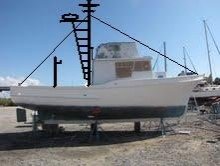phishown
Member
- Joined
- Aug 19, 2010
- Messages
- 17
I am new to the Trawler workd with the recent purchase of our first one being a 32' Monterey Clipper. * I am in the process of installing a mast for radar and paravane stabilizers. *I will be lowering the mast aft with a tabernackle setup about 30 degrees to be able to pass under bridges while leaving and coming back to port. *My plan is to use a anchor windlass to lower and raise the mast. *I would like to use a Manual Windlass like the lawrence seatiger 555 or 308 goiliti. *Because I am not familiar with windlass operations...Would the manual windlass be able to work in both directions (anchoring, lowering, and raising the mast)?*
Thanks for your Help
Mark
Thanks for your Help
Mark

